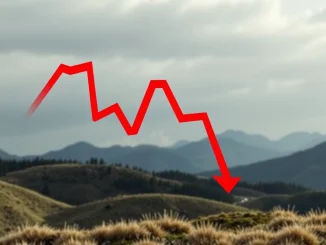
Buckle up, investors! The financial world just witnessed a significant tremor as all three major U.S. stock indexes closed in the red. If you’re keeping an eye on the markets, especially the volatile crypto sphere, these kinds of shifts in traditional finance can send ripples across the entire investment landscape. Let’s dive into what happened and what it could mean for you.
What Triggered This Shocking Market Downturn?
On a day that many investors would rather forget, the U.S. stock market experienced a broad sell-off, leading to substantial losses across the board. The numbers are stark and paint a clear picture of a widespread market downturn:
- S&P 500: Dropped by a significant 4.84%.
- Nasdaq Composite: Suffered an even steeper fall of 5.97%.
- Dow Jones Industrial Average: Decreased by a considerable 3.98%.
These aren’t just minor dips; these are substantial percentage drops indicating a widespread negative sentiment gripping the market. But what exactly fueled this stock market crash? While pinpointing a single cause is often an oversimplification, several factors likely contributed to this widespread sell-off. These could range from concerns about rising interest rates and persistent inflation to geopolitical uncertainties and potentially disappointing earnings reports from major companies. The market often reacts to a complex interplay of these factors, and on this particular day, the combination proved to be a potent cocktail for bearish momentum.
Breaking Down the Losses: Why Did the US Stock Indexes Plunge?
Let’s take a closer look at each of the major indexes and understand the magnitude of the US stock indexes‘ decline:
| Index | Percentage Change | Description |
|---|---|---|
| S&P 500 | -4.84% | Often considered the benchmark of the U.S. stock market, the S&P 500 represents 500 of the largest publicly traded companies in the United States. A nearly 5% drop is a significant movement, indicating broad weakness across major sectors. |
| Nasdaq Composite | -5.97% | The Nasdaq is heavily weighted towards technology stocks. Its steeper decline suggests that tech companies, which have been market leaders for years, faced particularly strong selling pressure. This could be due to concerns about future growth prospects in a potentially slowing economy, or profit-taking after a long period of tech dominance. |
| Dow Jones Industrial Average | -3.98% | The Dow 30, composed of 30 large, established companies, also experienced a significant downturn, though slightly less severe than the Nasdaq and S&P 500 in percentage terms. This still represents a substantial loss in value for some of the most well-known companies in the world. |
The sheer scale of these declines across all major indexes underscores the pervasive nature of the negative market sentiment on this day. No sector was spared, and investors broadly moved to reduce their exposure to equities.
Investor Anxiety: What Does an S&P 500 Decline of This Magnitude Mean?
A significant S&P 500 decline like this can understandably trigger anxiety among investors. For those with portfolios tied to these indexes, whether directly through index funds or indirectly through broader market investments, such a drop translates to immediate paper losses. Beyond the immediate financial impact, it also raises questions about the overall health and direction of the economy. Is this a temporary correction, or the start of a more prolonged bear market? Such uncertainty can lead to further selling pressure as investors try to protect their capital.
For cryptocurrency enthusiasts, events in the traditional stock market are also keenly watched. While crypto operates in its own ecosystem, it’s not entirely insulated from traditional finance. Often, we see correlations – when the stock market falters, risk assets like cryptocurrencies can also experience increased volatility and potential downward pressure. This interconnectedness means that understanding these Nasdaq plunge events is crucial for anyone navigating the broader investment landscape, including the digital asset space.
Navigating Market Volatility: Actionable Insights for Investors
So, what should investors do in the face of such market volatility? Here are a few actionable insights to consider:
- Don’t Panic Sell: While seeing red in your portfolio is unsettling, making impulsive decisions based on fear can often lock in losses. Market corrections are a normal part of the economic cycle.
- Review Your Portfolio: Take this as an opportunity to re-evaluate your portfolio’s risk tolerance and diversification. Is your asset allocation still aligned with your long-term financial goals?
- Consider Dollar-Cost Averaging: For long-term investors, market downturns can present buying opportunities. Dollar-cost averaging, investing a fixed amount regularly regardless of market conditions, can be a strategy to build positions over time.
- Stay Informed, But Avoid Over-Monitoring: Keep abreast of market news, but avoid constantly checking your portfolio, which can exacerbate anxiety during volatile periods.
- Seek Professional Advice: If you’re unsure how to navigate these market conditions, consulting with a financial advisor can provide personalized guidance.
Conclusion: Weathering the Storm and Looking Ahead
The recent US stock indexes‘ sharp decline serves as a potent reminder of the inherent volatility of financial markets. While days like these can be unnerving, they are also part of the investment journey. Understanding the underlying factors, maintaining a long-term perspective, and making informed decisions rather than emotional reactions are key to weathering these storms and positioning yourself for future financial success. For crypto investors and traditional market participants alike, staying informed and adaptable is paramount in navigating the ever-changing financial landscape.



